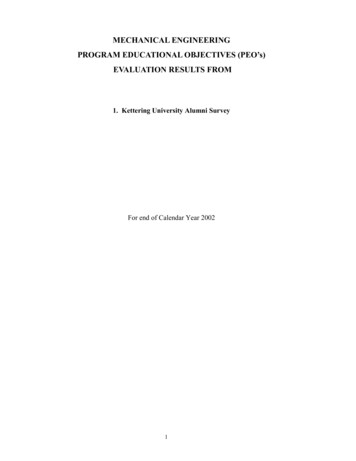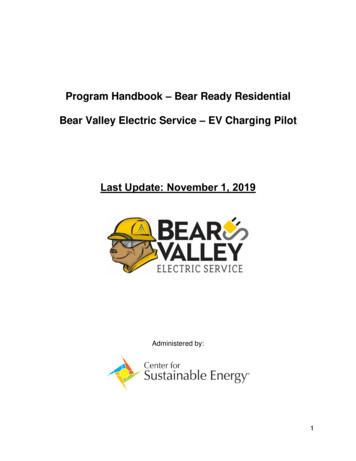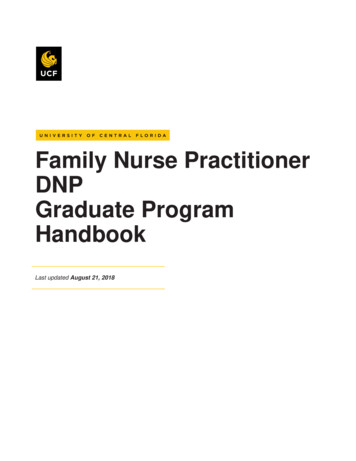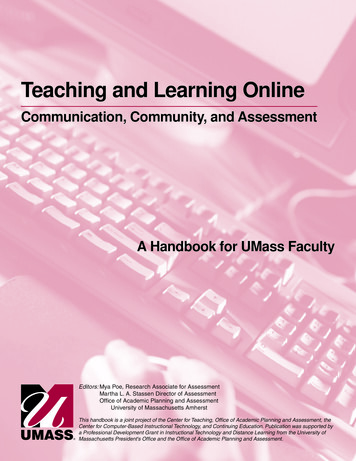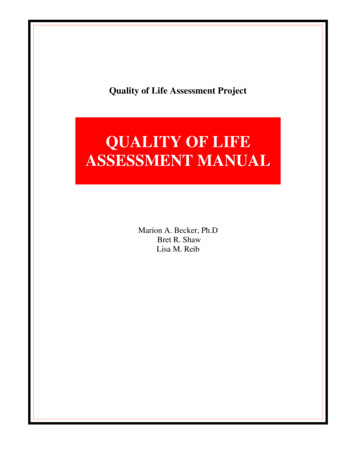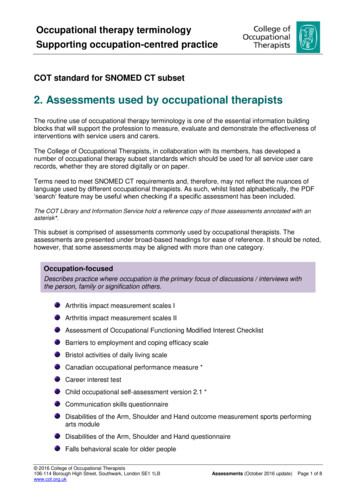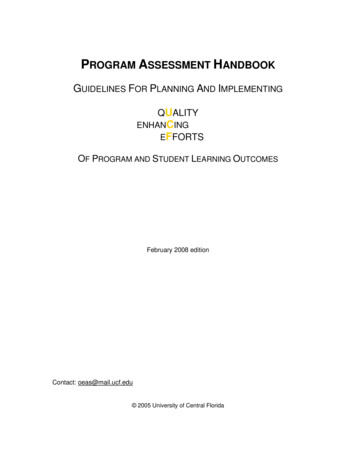
Transcription
PROGRAM ASSESSMENT HANDBOOKGUIDELINES FOR PLANNING AND IMPLEMENTINGQUALITYENHANCINGEFFORTSOF PROGRAM AND STUDENT LEARNING OUTCOMESFebruary 2008 editionContact: oeas@mail.ucf.edu 2005 University of Central Florida
PROGRAM ASSESSMENT HANDBOOKGUIDELINES FOR PLANNING AND IMPLEMENTINGQUALITYENHANCINGEFFORTSOF PROGRAM AND STUDENT LEARNING OUTCOMESThe purpose of this handbook is to provide academic programs with a framework fordeveloping an assessment plan with the objective of improving an academic program.In Chapter 1, an overview of assessment and more specifically program assessment isintroduced. Guidelines and suggestions for planning for program assessment areprovided in Chapter 2. Methods that can be used to assist the department in developingits mission and program goals statements are included in Chapter 3. Chapter 4 isdescribes the development of student learning outcomes and includes a checklist and apreparation form to aid those involved in the assessment process. An inventory ofprogram assessment tools, methods and techniques is outlined in Chapter 5. Chapter 6provides an overview of documenting and using data from assessment.We would like to acknowledge the work of colleagues at other institutions (referenced throughoutthe handbook).
MOST COMMON MISCONCEPTIONS ABOUTPROGRAM ASSESSMENTMisconception 1: The results of assessment will be used to evaluate facultyperformance.Nothing could be further from the truth. Faculty awareness, participation, and ownershipare essential for successful program assessment, but assessment results should neverbe used to evaluate or judge individual faculty performance. The results of programassessment are used to improve programs.Misconception 2: Our program is working well, our students are learning; we don’tneed to bother with assessment.The primary purpose of program assessment is to improve the quality of educationalprograms by improving student learning. Even if you feel that the quality of yourprogram is good, there is always room for improvement. In addition, various accreditingbodies mandate conducting student outcomes assessment. For example, the SouthernAssociation of Colleges and Schools (SACS) requires that every program assess itsstudent outcomes and uses the results to improve programs. Not to conductassessment is not an option.Misconception 3: We will assign a single faculty member to conduct theassessment. Too many opinions would only delay and hinder the process.While it is a good idea to have one or two faculty members head the assessmentprocess for the department, it is really important and beneficial to have all facultymembers involved. Each person brings to the table different perspectives and ideas forimproving the academic program. Also it is important that all faculty membersunderstand and agree to the mission (i.e., purpose) and goals of the academic program.Misconception 4: The administration might use the results to eliminate some ofthe department’s programs.There are two types of evaluation processes: summative and formative. The purpose ofsummative program evaluation is to judge the quality and worth of a program. On theother hand, the purpose of formative program evaluation is to provide feedback to helpimprove and modify a program. Program assessment is intended as a formativeevaluation and not a summative evaluation. The results of program assessment will notbe used to eliminate programs.Misconception 5: Assessment is a waste of time and does not benefit thestudents.The primary purpose of assessment is to identify the important objectives and learningoutcomes for your program with the purpose of improving student learning. Anythingthat enhances and improves the learning, knowledge and growth of your studentscannot be considered a waste of time. 2005 University of Central FloridaUCF Academic Program Assessment HandbookOperational Excellence and Assessment SupportiFebruary 2008
Misconception 6: We will come up with an assessment plan for this year and use itevery year thereafter.For program assessment to be successful, it must be an ongoing and continuousprocess. Just as your program should be improving, so should your assessment planand measurement methods. Each academic department must look at its programs andits learning outcomes on a continual basis and determine if there are better ways tomeasure student learning and other program outcomes. Your assessment plan shouldbe continuously reviewed and improved.Misconception 7: Program assessment sounds like a good idea, but it is timeconsuming and complex.It is impossible to “get something for nothing.” Effective program assessment will takesome of your time and effort, but there are steps that you can follow that can help you todevelop an assessment plan that will lead to improving student learning. Also, the officeof Operational Excellence and Assessment Support (OEAS) is available to provide youwith assistance. If you need any help go to http://oeas.ucf.edu, the OperationalExcellence and Assessment Support website for guidelines and assistance inconducting program assessment or contact the office (407-882-0277) to make anappointment for a consultation. 2005 University of Central FloridaUCF Academic Program Assessment HandbookOperational Excellence and Assessment SupportiiFebruary 2008
HANDBOOK CONTENTSWhat is assessment and why should you assess?Chapter 1 provides an overview of the assessment process at UCF and defines theconcept of program assessment. Also, this chapter introduces the purposes andcharacteristics of assessment to help you when you are thinking about how assessmentcan benefit your program.How should you plan for program assessment?Chapter 2 provides guidelines and suggestions for developing a plan for programassessment. Designing an assessment plan is not an easy task. The objectives of thischapter are to introduce the steps involved in designing an assessment plan and providesuggestions to help you tailor the plan to match the learning outcomes of your program.How do you define program mission and goals?Chapter 3 provides several strategies to assist in defining the program’s mission andidentifying program goals. Understanding and clearly stating what your program is tryingto accomplish serve as a foundation for a successful assessment plan. It is important todefine and obtain a consensus on program goals. There are some guidelines that yourprogram can follow to help you do this.How do you define student learning outcomes?Chapter 4 provides an overview and definition of program objectives (student learningoutcomes) and stresses the importance of explicitly defining expectations and standards.Also included is an extensive discussion on how to write clear and precise statements ofoutcomes for your program. This is an integral part of an assessment plan and yourdepartment should focus on defining clear statements of program level student learningoutcomes.How do you select and develop assessment methods?Chapter 5 presents a discussion on guidelines and criteria for selecting the appropriateassessment methods for each student learning outcome. Additionally, an inventory ofassessment methods and techniques that are currently available or can be developed oradapted to your program is presented.How do you document and use the results to improve programs?Chapter 6 provides an overview of how to document the results and use the results toimprove your program. Documentation is necessary in order to communicate withothers, including accreditation agencies, how well your students are learning. Reviewingthe data on student performance can point to areas in your program that requirestrengthening. 2005 University of Central FloridaUCF Academic Program Assessment HandbookOperational Excellence and Assessment SupportiiiFebruary 2008
TABLE OF CONTENTSMost Common Misconceptions About Program Assessment . iHandbook Contents . iiiTable of Contents .vi1.0OVERVIEW OF ASSESSMENT . 1Chapter learning outcomes . 1Background on program assessment at UCF . 2Introduction to program assessment . 2Purposes of program assessment . 3Characteristics of effective program assessment . 4Nine principles of assessment . 5Sources and additional references . 62.0DEVELOPING AN ASSESSMENT PLAN . 7Chapter learning outcomes . 7Introduction to developing an assessment plan . 7Developing a program assessment plan . 8Flowchart describing assessment process . 14Sources and additional references . 15Appendix 2A: Preliminary checklist for identifying program needs .2A-13.0DEFINING PROGRAM MISSION AND GOALS . 16Chapter learning outcomes . 16Program mission statement . 17Defining the program mission statement . 17Format of a mission statement . 18Examples of program mission statements . 18Program vision (optional) . 19Defining the program vision statement . 19Example of a program vision statement . 19Program values and guiding principles (optional) . 19Defining the program’s values and guiding principles . 19Example of a value statement . 20Example of a guiding principle. 20Program goals (optional) . 20Defining program goals . 20Getting started . 21Writing program goals . 23Format of a goal statement. 23Examples of program goals . 23Reviewing your program goals . 24Sources and additional references . 25Appendix 3A: Guidelines for writing an effective mission statement .3A-1Appendix 3B: Checklist for reviewing a mission statement .3B-1Appendix 3C: Checklist on writing and reviewing a vision statement . 3C-1Appendix 3D: Worksheet for identifying and defining program goals or learningoutcomes . 3D-1Appendix 3E: Checklist for reviewing goal statements .3E-1 2005 University of Central FloridaUCF Academic Program Assessment HandbookOperational Excellence and Assessment SupportivFebruary 2008
4.0DEFINING STUDENT LEARNING OUTCOMES (SLO) . 26Chapter learning outcomes . 26Defining student learning outcomes . 27Curriculum and Syllabus Analysis . 28Benefits of student learning outcomes . 28Developing student learning outcomes . 30Types and levels of educational objectives . 31Key words . 33Guidelines for writing student learning outcome statements . 35Format of a learning outcome statement . 38Examples of learning outcome statements . 40Sources and additional references . 43Appendix 4A: Summary of guidelines for developing student learningOutcomes .4A-1Appendix 4B: Checklist for reviewing student learning outcomes .4B-15.0ASSESSMENT METHODS . 44Taxonomy of assessment methods . 44Helpful hints for selecting assessment methods . 46Before you start developing the assessment plan . 49Criteria for selecting assessment methods . 50Challenges to selecting assessment methods . 52Inventory of assessment methods . 53Description of direct assessment methods . 55Description of indirect assessment methods . 61Other indirect assessment methods . 646.0USE OF RESULTS . 65Chapter learning outcomes . 65Reviewing and interpreting data . 65Summarizing collected data . 67Summary of types of changes made as a result of conductingAssessment . 69Developing recommendations for change . 69Develop plan to monitor changes and compare current data withPrevious year’s data . 70Publishing results of assessment . 72Sources and additional references . 75Appendix 6A: Examples of assessment mapping .6A-1 2005 University of Central FloridaUCF Academic Program Assessment HandbookOperational Excellence and Assessment SupportvFebruary 2008
CHAPTER 1OVERVIEW OF ASSESSMENTPurpose of this ChapterKEY TOPICSThe purpose of this chapter is to provide an overview of the assessment process at UCFand to define the concept of program assessment. Also, this chapter introduces you thepurposes of assessment and characteristics of a good assessment process to help youwhen you are thinking about how assessment can benefit your program.The key topics presented in this Chapter are: Chapter learning outcomes Background on assessment at UCF Introduction to program assessment Purposes of program assessment Characteristics of effective program assessment Nine principles of assessment Sources and additional referencesChapter learning outcomesReaders of this chapter will have the ability to: understand the assessment process at UCFdifferentiate between different types of assessment (classroom, course, programand institutional)identify the purposes of engaging in program assessmentestablish that assessment is not a means of evaluating, faculty, staff or students,rather it is a feedback mechanismrecognize that program assessment is intended to identify ways of improvingstudent learningcomprehend that assessment has to be systematic and ongoingunderstand that effective program assessment is achieved by examining whatare we doing, how well we are doing it and how can we improve what we aredoing 2005 University of Central FloridaUCF Academic Program Assessment HandbookOperational Excellence and Assessment Support1February 2008
Background on assessment at UCFInstitutions of higher learning are becoming increasingly involved in conductingassessment within their academic programs and administrative support organizations.The desire to know how well the institution and its programs are doing and to improveservice and student learning are all motivators for conducting assessment.Institutions are facing internal and external pressures to increase quality even whilefunding resources are reduced. Increasingly, various organizations that accreditacademic programs (e.g., NCATE, ABET, and AACSB) are requiring that institutionsassess how well the programs are meeting their objectives to inform improvementefforts. The State of Florida is increasingly holding its institutions accountable forachieving student learning outcomes. The ability for institutions in the South to offerstudent financial aid (from federal sources) depends on their ability to remain accreditedby the Southern Association of Colleges and Schools (SACS). In part, this requires thatthe institution demonstrates that it has an active assessment process that continuouslyexamines the services and programs and leads to improvement. According to SACS:“The institution identifies expected outcomes for its educational programs and itsadministrative and educational support services; assesses whether it achieves theseoutcomes; and provides evidence of improvement based on analysis of those results.”UCF’s strategic goals and initiatives demand a focus on operational excellence andcontinuous quality improvement. A commitment to continuous quality improvementrequires a shared devotion to quality that surpasses other personal and short-termconcerns.In 1994, the University of Central Florida (UCF) established a goal that all academic andadministrative units would develop mission statements, learning outcomes, and at leastthree outcome measures to assess and improve programs, operations, and services.Today, every academic program and administrative unit at UCF is required to submit inthe Fall an assessment plan for the coming year and document the results of their priorassessment. These plans and results are reviewed by Divisional Review Committeeswithin each college and major administrative area, and then presented to the UniversityAssessment Committee for final approval. President Hitt established the UniversityAssessment Committee in 1996 to provide quality assurance of UCF’s programassessment process. In 2000, the office of Operational Excellence and AssessmentSupport was established, in part, to provide support to UCF’s program assessmentprocess.Introduction to program assessmentDefinitionAssessment is the systematic and ongoing method of gathering, analyzing andusing information from measured outcomes to improve student learning.In higher education the term “assessment” can mean a variety of things. It can refer tothe process of grading an individual student’s achievement on a test or assignment or itcan refer to the process of evaluating the quality of an academic program. The overallpurpose of program assessment does not focus on an individual student. Rather, the 2005 University of Central FloridaUCF Academic Program Assessment HandbookOperational Excellence and Assessment Support2February 2008
emphasis is on what and how an educational program is contributing to the learning,growth and development of students as a group.There are four levels of assessment: 1. classroom assessment (involves assessment ofindividual students at the course level typically by the class instructor), 2. courseassessment (involves assessment of a specific course), 3. program assessment(involves assessment of academic and support programs and is the focus of thismanual), and 4. institutional assessment (involves assessment of campus-widecharacteristics and issues).(Adapted from Palomba and Banta, 1999; and Stassen, Doherty, and Poe, 2001)Of NoteThis manual focuses on program-level assessment.Program assessment is defined as the systematic and ongoing method of gathering,analyzing and using information from various sources about a program andmeasuring program outcomes in order to improve student learning. This is donethrough obtaining a good understanding of what the program’s graduates know, whatthey can do with this knowledge, and what they value as a result of this knowledge.Program assessment, as it is addressed in this manual, can also be called studentoutcomes assessment, which places an emphasis on the learning, development andgrowth of students.(Adapted from definitions by Huba and Freed, 2000; Hutchings and Marchese, 1990; andPalomba and Banta, 1999)Of NoteProgram assessment should not be an evaluation of individual students, faculty orstaff. It is a process used to provide a program with feedback on its performance withthe intent of helping improve the program and in particular, improve student learning.Purposes of program assessmentThe four main purposes of program assessment are:1. To improve – the assessment process should provide feedback to determinehow the program can be improved.2. To inform – the assessment process should inform faculty and other decisionmakers of the contributions and impact of the program.3. To prove – the assessment process should encapsulate and demonstrate tostudents, faculty, staff and outsiders what the program is accomplishing.(Adapted from Outcomes Assessment Manual, 2000; and WEAVE: A Quality EnhancementGuide, 2000)4. To support – the assessment process should provide support for campusdecision-making activities such as program review and strategic planning, as wellas external accountability activities such as accreditation. 2005 University of Central FloridaUCF Academic Program Assessment HandbookOperational Excellence and Assessment Support3February 2008
Of NoteWhen developing the assessment plan for your program, always refer back to thefour main purposes of assessment: improve, inform, prove, and support.Characteristics of effective program assessmentEffective program assessment should answer these questions:1. What are you trying to do?2. How well are you doing it?3. Using the answers to the first two questions, how can you improve whatyou are doing?4. What and how does a program contribute to the development andgrowth of its students?5. How can student learning be improved?(Adapted from Hutchings and Marchese, 1990)Of NoteThe assessment process of your program should try to address these questions.Remember to refer to them while you are conducting your assessment activities.Additionally, program assessment is effective when:1.2.3.4.5.6.Assessment is viewed as a comprehensive, systematic and continuous process.Assessment is viewed as a means for self-improvement.Assessment measures are meaningful.Assessment utilizes multiple measures and multiple sources.Assessment is used as a management tool.Assessment results are valued and are genuinely used to improve programsand processes.7. Assessment is coordinated by one person and reviewed by a committee.8. Assessment involves the participation and input of all faculty and staff.9. Assessment includes students.Of NoteAssessment should NOT:Be viewed as an evaluation or accountability process.Be accepted as being optional.Be used to compare programs.(Adapted from Stassen, Doherty, and Poe, 2001; and Guidelines for Assessment, 1993) 2005 University of Central FloridaUCF Academic Program Assessment HandbookOperational Excellence and Assessment Support4February 2008
Nine principles of assessmentNine Principles of Assessment were developed by a task force from the AmericanAssociation for Higher Education (Alexander W. Astin; Trudy W. Banta; K. PatriciaCross; Elain El-Khawas; Peter T. Ewell; Pat Hutchings; Theodore J. Marchese, Kay M.McClenney; Marcia Mentkowski, Margaret A. Miller; E. Thomas Moran; and Barbara D.Wright).The link to the original article e nine principles include:1. The assessment of student learning begins with educational values.2. Assessment is most effective when it reflects an understanding of learning asmultidimensional, integrated, and revealed in performance over time.3. Assessment works best when the programs it seeks to improve have clear,explicitly stated purposes.4. Assessment requires attention to outcomes but also and equally to theexperiences that lead to those outcomes.5. Assessment works best when it is ongoing, not episodic.6. Assessment fosters wider improvement when representatives from across theeducational community are involved.7. Assessment makes a difference when it begins with issues of use and illuminatesquestions that people really care about.8. Assessment is more likely to lead to improvement when it is part of a larger set ofconditions that promote change.9. Through assessment, educators meet responsibilities to students and to thepublic. 2005 University of Central FloridaUCF Academic Program Assessment HandbookOperational Excellence and Assessment Support5February 2008
Sources and additional referencesGuidelines for Assessment, (Publication. (1993 ). Retrieved February 11, 2008, fromCalifornia State University .htmlHuba, & Freed. (2000). Learner-Centered Assessment on College Campuses. Boston:Alyn and Bacon.Hutchings, P., & Marchese, T. (1990). Watching Assessment: Questions, Stories,Prospects. Change.The Magazine of Higher Learning, 22(5), 12 -38.Operational Excellence and Assessment Support. (2003). University of Central Floridawebsite. Retrieved February 11, 2008, from http://oeas.ucf.eduOutcomes Assessment Manual. (2000). Retrieved February 11, 2008, from University ofWisconsin, Madison Assessment ual/Palomba, C., & Banta, T. (1999). Assessment Essentials: Planning, Implementing, andImproving Assessment in Higher Education. San Francisco: Jossey-Bass.Pet-Armacost, J., & Armacost, R. (2003). Challenges in Communicating InnovativeAssessment Approaches. Paper presented at the AAHE Assessment Forum.Pet-Armacost, J., Armacost, R., & Young, D. (2003). Transforming the AssessmentCulture: One University’s Story Paper presented at the 2003 AAHE AssessmentForum.Stassen, M., Doherty, K., & Poe, M. (2001). Program-Based Review and Assessment.Retrieved February 11, 2008, from University of Massachusetts Amherst Officeof Academic Planning and Assessment am based.pdfWEAVE: A Quality Enhancement Guide for Academic Programs and Administrative andEducational Support Units (2000). Retrieved February 11, 2008, from VirginiaCommonwealth University: www.vcu.edu/quality/pdfs/WEAVEManual2002.pdf 2005 University of Central FloridaUCF Academic Program Assessment HandbookOperational Excellence and Assessment Support6February 2008
CHAPTER 2DEVELOPING AN ASSESSMENT PLANPurpose of this ChapterKEY TOPICSThe purpose of this chapter is to provide guidelines and suggestions for developing aplan for program assessment. Designing an assessment plan is not an easy task. Theobjectives of this chapter are to introduce you to the steps involved in designing anassessment plan and to provide you with suggestions to help you tailor the plan to matchthe learning outcomes of your program.The key topics presented in this Chapter are: Chapter learning outcomes Introduction to developing an assessment plan Developing a program assessment plan Flowchart describing assessment process Sources and additional referencesAppendix 2A: Preliminary checklist for identifying program needsChapter learning outcomesReaders of this chapter will have the ability to: recognize that a program assessment plan should be manageable, meaningfuland sustainableidentify the needs of the program in order to develop an appropriate assessmentplancomprehend that assessment is a continuous improvement processutilize the plan-do-check-act cycle in developing a program assessment plantailored to the program needsunderstand and identify the various steps in the assessment processIntroduction to developing an assessment planA crucial part of developing an assessment plan is to clarify the focus and content ofyour plan, which should be based on the needs of your program or unit. Theassessment approach will depend on your program’s mission or purpose.Remember that the purpose of assessment can be to improve, inform, prove and/orsupport your program (refer to Chapter 1 for an explanation). Thinking of assessmentin these terms will help you identify your needs (which is the first phase) as well as helpyou in devising the a
For program assessment to be successful, it must be an ongoing and continuous process. Just as your program should be improving, so should your assessment plan and measurement methods. Each academic department must look at its programs and its learning outcomes on a continual basis and determine if there are better ways to

